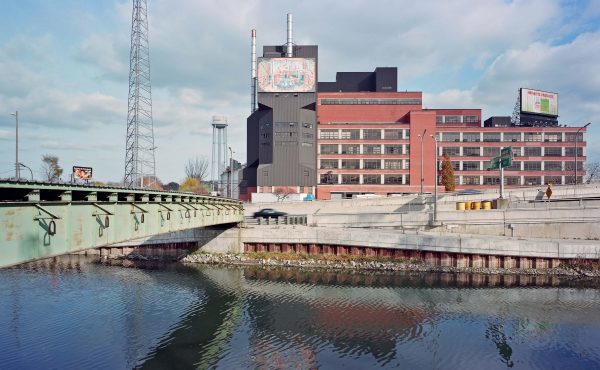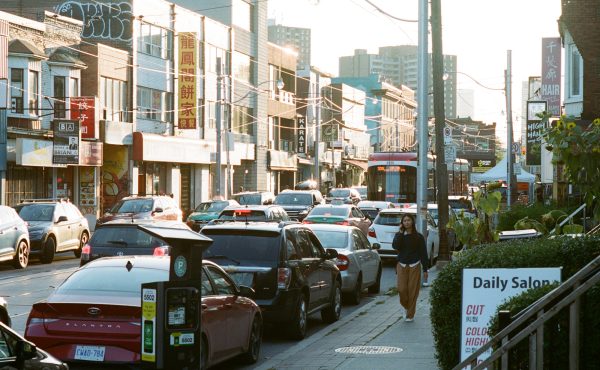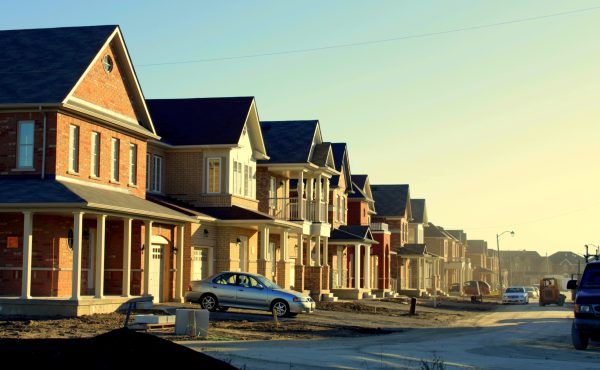
It’s a curious experience to read a book where you agree with most of the ideas, but cringe at the way they are expressed.
American urban planner Mark Hinshaw’s True Urbanism: Living at and Near the Center documents an important recent phenomenon — the revitalization of city centers and the areas immediately around these centers across North America, including the rapid increase in the number of residents living in these areas. It’s a phenomenon we have seen happening in Toronto over the last fifteen years. But one of the interesting purposes of Hinshaw’s book is to show that it’s not just happening in large, older east-coast and mid-western cities, but also in newer cities on the west coast, and in smaller towns. Hinshaw calls this phenomenon “true urbanism” to contrast it with the “new urbanism” movement.
This phenomenon is a positive one in many ways — environmentally, economically, culturally. It shows a renewed appreciation and understanding of the value of urban, rather than suburban, living. But, like any phenomenon, there are also potential problems that need to be looked at when talking about it. Hinshaw is keen to spread the gospel of urbanism, and writes in an easy and accessible style for a broad audience. Unfortunately, Hinshaw’s tone is so boosterish, he tends to gloss over any problems, which actually makes his arguments less convincing than they should be.
The first problem is that he constantly frames the appeal of downtown or near-downtown living primarily in terms of lifestyle. Throughout the book he repeats how people are attracted to living in these neighbourhoods by the prevalence of nice restaurants and cafes, art galleries and cool independent shops. Of course, this is part of the appeal — but there are much deeper, more profound reasons why people are making this move, such as economic reasons and time efficiency (you don’t have to spend as much time travelling). Hinshaw mentions these ideas in passing, but they really need to be looked at in depth to understand the phenomenon. He does talk more about the social attraction — the sense of being part of a complex neighbourhood, the “small-town feel”, but focuses on it as part of an appealing lifestyle rather than analyzing how this feeling might meet fundamental human needs.
The result of the emphasis on lifestyle is that in some places the book reads like Stuff White People Like without the irony. The danger is that it makes it easy to stereotype an important and useful phenomenon as a marginal self-indulgence by bohemian bourgeois.
Which brings us to the other problem — the demographics of this phenomenon. Hinshaw recognizes that the majority of people living in these “true urban” areas are middle-class and not living with children (whether single professionals, childless couples, or retirees). But he tends to gloss over this limited demographic, when it really needs to be thought about head-on, including its causes, the reasons it might be a problem, and systemic solutions. He devotes a chapter to the childless issue, telling an anecdote showing that it’s possible to raise children in a high-rise condo, and suggesting more family-sized units and townhouses.
In terms of income levels, he denies that this phenomenon is a form of gentrification. He describes the example of Seattle, which appears to have from the beginning had a systematic program, involving many different partners, to ensure a variety of income levels in a revitalized downtown. It’s a good example, but in most other cases, it seems like lower-income housing projects, whether for workers, artists, or the destitute, are exceptional tokens amidst a sea of middle-class condos. Maybe it’s not exactly gentrification, since many of the buildings are new, and it’s certainly a good thing that middle-class people want to live in and support downtowns again. But any demographic narrowness implies potential problems, which should be thought about. And if the goal is to make urbanism once again the primary way in which cities are built, it will have to be effective for a wider demographic.
The most cringeworthy part of the book is a section early on (pp. 13-15) where Hinshaw combines these two problems in a discussion of how great his own near-downtown neighbourhood is. He tries to show that it is diverse by describing all the nice, quaint ethnic shopkeepers who service his needs and provide exotic (yes, he uses that word) lifestyle choices for him within walking distance of his condo. It does not occur to him to ask where they live. His own condo building, he says, is diverse because he hears so many languages in the elevator — but they are mostly languages of developed nations, spoken by cosmopolitan professionals.
Hinshaw is much stronger in the later parts of the book when discussing the ways cities can encourage and develop true urbanism. His later chapters go into detail about planning issues, investment strategies, transportation options, and the like. I found his detailed analysis of the street-level planning approach needed to create an appealing yet flexible streetscape particularly informative. He provides numerous and wide-ranging examples and case studies, which are useful, sometimes fascinating, and even inspiring, showing how it is possible to turn around a neglected downtown remarkably rapidly and create a sustainable and appealing urban neighbourhood.
The book is not intended to apply directly to a city like Toronto, where there have been residential neighbourhoods near downtown without interruption, so that the current mix of central Toronto is probably more complex than those of the cities he focuses on. But it is worth comparing to Toronto, because the condo boom of the last decade shares many characteristics with what Hinshaw describes, and is clearly part of the same phenomenon.
The return of “true urbanism” is an important and postive phenomenon in North American cities. Dense, mixed-use neighbourhoods are the most effective way to make cities environmentally sustainable, and they also bring health, civic and economic benefits. In a way, Hinshaw seems to find its benefits so obvious that he has a hard time analyzing them in depth, or recognizing the related problems that need to be addressed. The result is that his book provides a useful first word on the subject, but is certainly not the last.




4 comments
Dylan,
You are bang on about the narrow demographics fueling this phenomenon. It should be of worry. While I have not read the book, I wonder if it addresses the affordability and speculative influences involved in fueling the trend.
It’s interesting contrasting what you wrote with Who’s Your City? by Richard Florida, which I just read. He describes a lot of the demographic challenges faced by urban neighborhoods, and the impacts of differing settlement patterns. It might make for an interesting companion piece to this book.
Hi Glen – I’d say that Hinshaw tries to address the affordability issue with various examples of ways to keep affordable spaces in these areas, but I didn’t come away feeling it was very satisfactory. He doesn’t really address speculation.
David – I’m planning to read Who’s Your City? – I look forward to seeing what Florida says.
Thanks Dylan.